

Compact Muon Solenoid
LHC, CERN
| CMS-HIG-22-001 ; CERN-EP-2022-039 | ||
| A portrait of the Higgs boson by the CMS experiment ten years after the discovery | ||
| CMS Collaboration | ||
| 4 July 2022 | ||
| Nature 607 (2022) 60-68 | ||
| Abstract: In July 2012, the ATLAS and CMS Collaborations at the CERN Large Hadron Collider announced the observation of a Higgs boson at a mass of around 125 GeV. Ten years later, and with the data corresponding to the production of 30 times larger number of Higgs bosons, we have learnt much more about the properties of the Higgs boson. The CMS experiment has observed the Higgs boson in numerous fermionic and bosonic decay channels, established its spin-parity quantum numbers, determined its mass and measured its production cross sections in various modes. Here the CMS Collaboration reports the most up-to-date combination of results on the properties of the Higgs boson, including the most stringent limit on the cross section for the production of a pair of Higgs bosons, on the basis of data from proton-proton collisions at a centre-of-mass energy of 13 TeV. Within the uncertainties, all these observations are compatible with the predictions of the standard model of elementary particle physics. Much evidence points to the fact that the standard model is a low-energy approximation of a more comprehensive theory. Several of the standard model issues originate in the sector of Higgs boson physics. An order of magnitude larger number of Higgs bosons, expected to be examined over the next fifteen years, will help deepen our understanding of this crucial sector. | ||
| Links: e-print arXiv:2207.00043 [hep-ex] (PDF) ; CDS record ; inSPIRE record ; HepData record ; Physics Briefing ; CADI line (restricted) ; | ||
| Figures | |

png pdf |
Figure 1:
Feynman diagrams for the leading Higgs boson interactions. Higgs boson production in (a) gluon-gluon fusion (ggH), (b) vector boson fusion (VBF), (c) associated production with a W or Z (V) boson (VH), (d) associated production with a top or bottom quark pair (ttH or bbH), (e, f) associated production with a single top quark (tH); with Higgs boson decays into (g) heavy vector boson pairs, (h) fermion-antifermion pairs, and (i, j) photon pairs or Z$ \gamma $; Higgs boson pair production: (k, l) via gluon-gluon fusion, and (m, n, o) via vector boson fusion. The different Higgs boson interactions are labelled with the coupling modifiers $\kappa $, and highlighted in different colours for Higgs-fermion interactions (red), Higgs-gauge-boson interactions (blue), and multiple Higgs boson interactions (green). The distinction between a particle and its antiparticle is dropped. |

png pdf |
Figure 2:
The agreement with the SM predictions for production modes and decay channels. Signal strength parameters extracted for (left) various production modes $\mu _i$, assuming $\mathcal {B}^f= (\mathcal {B}^f)_\text {SM}$, and (right) decay channels $\mu ^f$, assuming $\sigma _i = (\sigma _i)_\text {SM}$. The thick (thin) black lines indicate the 1 (2) s.d. confidence intervals, with the systematic and statistical components of the 1 s.d. interval indicated by the red and blue bands, respectively. The vertical dashed line at unity represents the values of $\mu _i$ and $\mu ^f$ in the SM. The covariance matrices of the fitted signal strength parameters are shown in Extended Data Fig. B.5. The $p$-value with respect to the SM prediction are 3.1% and 30.1% for the left and right plot, respectively. The $p$-value corresponds to the probability that a result deviates as much, or more, from the SM prediction as the observed one. |

png pdf |
Figure 2-a:
Signal strength parameters extracted for various production modes $\mu _i$, assuming $\mathcal {B}^f= (\mathcal {B}^f)_\text {SM}$. The thick (thin) black lines indicate the 1 (2) s.d. confidence intervals, with the systematic and statistical components of the 1 s.d. interval indicated by the red and blue bands, respectively. The vertical dashed line at unity represents the values of $\mu _i$ in the SM. The covariance matrix of the fitted signal strength parameters is shown in Extended Data Fig. B.5-a. The $p$-value with respect to the SM prediction is 3.1%. The $p$-value corresponds to the probability that a result deviates as much, or more, from the SM prediction as the observed one. |

png pdf |
Figure 2-b:
Signal strength parameters extracted for decay channels $\mu ^f$, assuming $\sigma _i = (\sigma _i)_\text {SM}$. The thick (thin) black lines indicate the 1 (2) s.d. confidence intervals, with the systematic and statistical components of the 1 s.d. interval indicated by the red and blue bands, respectively. The vertical dashed line at unity represents the values of $\mu ^f$ in the SM. The covariance matrix of the fitted signal strength parameters is shown in Extended Data Fig. B.5-b. The $p$-value with respect to the SM prediction is 30.1%. The $p$-value corresponds to the probability that a result deviates as much, or more, from the SM prediction as the observed one. |

png pdf |
Figure 3:
A portrait of the Higgs boson couplings to fermions and vector bosons. (left) Constraints on the Higgs boson coupling modifiers to fermions ($ {\kappa _\mathrm {f}}$) and heavy gauge bosons ($ {\kappa _\mathrm {V}}$), in different data sets: discovery (red), the full LHC Run 1 (blue), and the data presented here (black). The SM prediction corresponds to $ {\kappa _\mathrm {V}}= {\kappa _\mathrm {f}}= $ 1 (diamond marker). (right) The measured coupling modifiers of the Higgs boson to fermions and heavy gauge bosons, as functions of fermion or gauge boson mass, where $\upsilon $ is the vacuum expectation value of the BEH field (cf. Methods section A.7). For gauge bosons, the square root of the coupling modifier is plotted, to keep a linear proportionality to the mass, as predicted in the SM. The $p$-value with respect to the SM prediction for the right plot is 37.5%. |
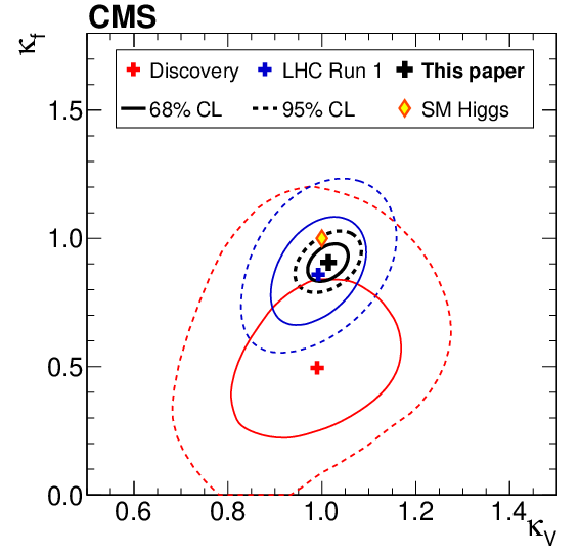
png pdf |
Figure 3-a:
Constraints on the Higgs boson coupling modifiers to fermions ($ {\kappa _\mathrm {f}}$) and heavy gauge bosons ($ {\kappa _\mathrm {V}}$), in different data sets: discovery (red), the full LHC Run 1 (blue), and the data presented here (black). The SM prediction corresponds to $ {\kappa _\mathrm {V}}= {\kappa _\mathrm {f}}= $ 1 (diamond marker). |

png pdf |
Figure 3-b:
The measured coupling modifiers of the Higgs boson to fermions and heavy gauge bosons, as functions of fermion or gauge boson mass, where $\upsilon $ is the vacuum expectation value of the BEH field (cf. Methods section A.7). For gauge bosons, the square root of the coupling modifier is plotted, to keep a linear proportionality to the mass, as predicted in the SM. The $p$-value with respect to the SM prediction is 37.5%. |
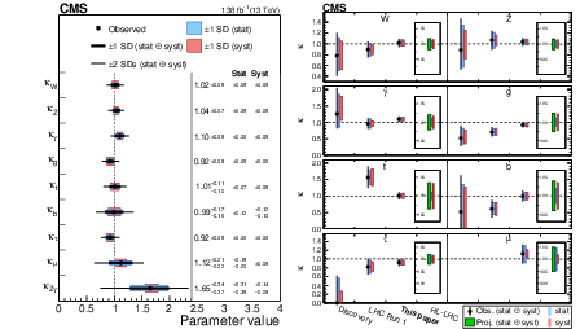
png pdf |
Figure 4:
Coupling modifiers measurements and their evolution in time. (left) Coupling modifiers resulting from the fit. The $p$-value with respect to the SM prediction is 28%. (right) Observed and projected values resulting from the fit in the $\kappa $-framework in different data sets: at the time of the Higgs boson discovery, using the full data from LHC Run 1, in the data set used in this paper, and the expected 1 s.d. uncertainty at the HL-LHC for $\mathcal {L}=$ 3000 fb$^{-1}$. The H $ \to \mu \mu $ and $\kappa _{\mathrm{t}}$ measurements were not available for earlier data sets due to the lack of sensitivity. |

png pdf |
Figure 4-a:
Coupling modifiers resulting from the fit. The $p$-value with respect to the SM prediction is 28%. |

png pdf |
Figure 4-b:
Observed and projected values resulting from the fit in the $\kappa $-framework in different data sets: at the time of the Higgs boson discovery, using the full data from LHC Run 1, in the data set used in this paper, and the expected 1 s.d. uncertainty at the HL-LHC for $\mathcal {L}=$ 3000 fb$^{-1}$. The H $ \to \mu \mu $ and $\kappa _{\mathrm{t}}$ measurements were not available for earlier data sets due to the lack of sensitivity. |

png pdf |
Figure 5:
Limits on the production of Higgs boson pairs and their time evolution. (left) The expected and observed limits on the ratio of experimentally estimated production cross section and the expectation from the SM ($\sigma _\text {Theory}$) in searches using different final states and their combination. The search modes are ordered, from upper to lower, by their expected sensitivities from the least to the most sensitive. The overall combination of all searches is shown by the lowest entry. (right) Expected and observed limits on HH production in different data sets: early LHC Run 2 data (35.9 fb$^{-1}$), present results using full LHC Run 2 data (138 fb$^{-1}$), and projections for the HL-LHC (3000 fb$^{-1}$). |
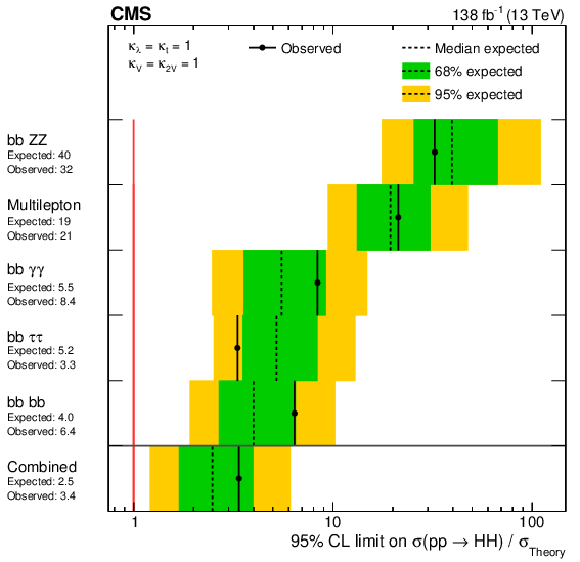
png pdf |
Figure 5-a:
The expected and observed limits on the ratio of experimentally estimated production cross section and the expectation from the SM ($\sigma _\text {Theory}$) in searches using different final states and their combination. The search modes are ordered, from upper to lower, by their expected sensitivities from the least to the most sensitive. The overall combination of all searches is shown by the lowest entry. |

png pdf |
Figure 5-b:
Expected and observed limits on HH production in different data sets: early LHC Run 2 data (35.9 fb$^{-1}$), present results using full LHC Run 2 data (138 fb$^{-1}$), and projections for the HL-LHC (3000 fb$^{-1}$). |
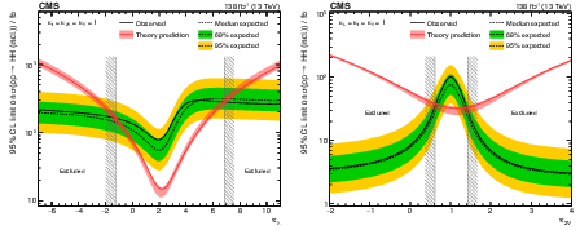
png pdf |
Figure 6:
Limits on the Higgs boson self-interaction and quartic coupling. Combined expected and observed 95% CL upper limits on the HH production cross section for different values of $\kappa _{\lambda}$ (left) and $ {\kappa _\mathrm {2V}}$ (right), assuming the SM values for the modifiers of Higgs boson couplings to top quarks and vector bosons. The green and yellow bands represent, respectively, the 1 and 2 s.d. extensions beyond the expected limit; the red solid line (band) shows the theoretical prediction for the HH production cross section (its 1 s.d. uncertainty). The areas to the left and to the right of the hatched regions are excluded at 95% CL. |

png pdf |
Figure 6-a:
Combined expected and observed 95% CL upper limits on the HH production cross section for different values of $\kappa _{\lambda}$, assuming the SM values for the modifiers of Higgs boson couplings to top quarks and vector bosons. The green and yellow bands represent, respectively, the 1 and 2 s.d. extensions beyond the expected limit; the red solid line (band) shows the theoretical prediction for the HH production cross section (its 1 s.d. uncertainty). The areas to the left and to the right of the hatched regions are excluded at 95% CL. |

png pdf |
Figure 6-b:
Combined expected and observed 95% CL upper limits on the HH production cross section for different values of $ {\kappa _\mathrm {2V}}$, assuming the SM values for the modifiers of Higgs boson couplings to top quarks and vector bosons. The green and yellow bands represent, respectively, the 1 and 2 s.d. extensions beyond the expected limit; the red solid line (band) shows the theoretical prediction for the HH production cross section (its 1 s.d. uncertainty). The areas to the left and to the right of the hatched regions are excluded at 95% CL. |

png pdf |
Figure B1:
The CMS detector at the CERN LHC. Schematic longitudinal cut-away view of the CMS detector, showing the different layers around the LHC beam axis, with the collision point in the centre. |

png pdf |
Figure B2:
Higgs boson candidate events. (upper) An event display of a candidate H $ \to $ ZZ $ \to $ ee$\mu \mu $. (lower) An event display of an H $ \to $ bb candidate produced in association with a Z boson decaying into an electron-positron pair, in pp collisions at $\sqrt {s} = $ 13 TeV recorded by CMS. The charged-particle tracks, as reconstructed in the inner tracker, are shown in yellow; the electrons are shown in green, the energy deposited by the electrons in the ECAL is shown as large green towers, the size of which is proportional of the amount of energy deposited; the blue towers are indicative of the energy deposits in the HCAL, while the red boxes are the muon chambers crossed by the muons (red tracks); the yellow cones represent the reconstructed jets. (lower, inset) The zoom into the collision region shows the displaced secondary vertices (in red) of the two b quarks decaying away from the primary vertex (in yellow). One of the bottom hadrons decays into a charm hadron that moves away from the secondary vertex before decaying (b $ \to $ c $\to$ X; vertex in cyan). |
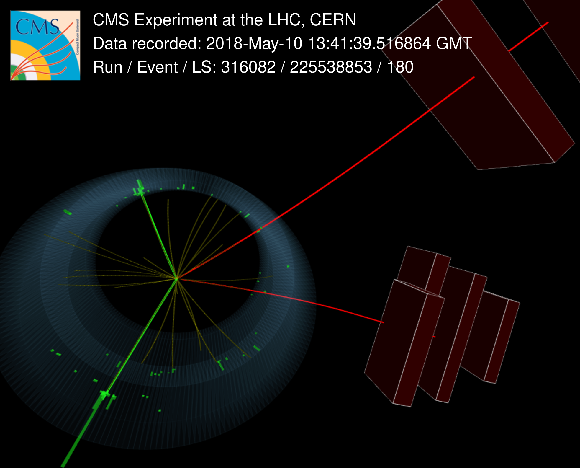
png pdf |
Figure B2-a:
An event display of a candidate H $ \to $ ZZ $ \to $ ee$\mu \mu $. The charged-particle tracks, as reconstructed in the inner tracker, are shown in yellow; the electrons are shown in green, the energy deposited by the electrons in the ECAL is shown as large green towers, the size of which is proportional of the amount of energy deposited; the red boxes are the muon chambers crossed by the muons (red tracks). |

png pdf |
Figure B2-b:
An event display of an H $ \to $ bb candidate produced in association with a Z boson decaying into an electron-positron pair, in pp collisions at $\sqrt {s} = $ 13 TeV recorded by CMS. The charged-particle tracks, as reconstructed in the inner tracker, are shown in yellow; the electrons are shown in green, the energy deposited by the electrons in the ECAL is shown as large green towers, the size of which is proportional of the amount of energy deposited; the blue towers are indicative of the energy deposits in the HCAL; the yellow cones represent the reconstructed jets. The zoom into the collision region shows the displaced secondary vertices (in red) of the two b quarks decaying away from the primary vertex (in yellow). One of the bottom hadrons decays into a charm hadron that moves away from the secondary vertex before decaying (b $ \to $ c $\to$ X; vertex in cyan). |
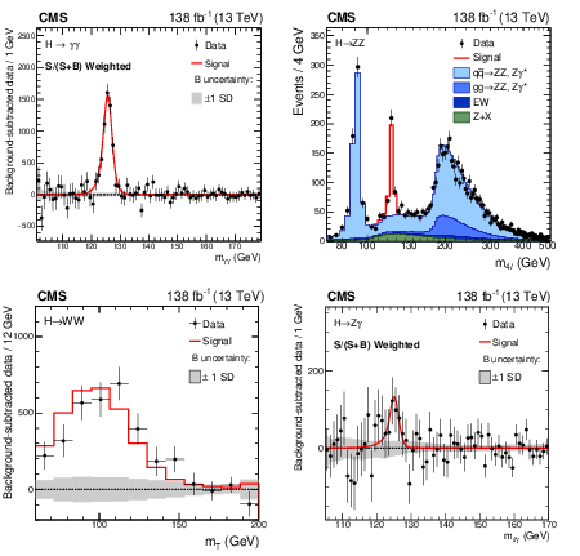
png pdf |
Figure B3:
Higgs boson mass peak in diboson decay channels. (upper left) The background-subtracted diphoton invariant mass distribution targeting the study of the decay channel H $ \to \gamma \gamma $. (upper right) The invariant mass distribution of four charged leptons targeting the study of the decay channel H $ \to $ ZZ $ \to $ 4$\ell$. (lower left) The background-subtracted transverse mass ${m_{\mathrm {T}}}$ distribution targeting the study of the decay channel H $ \to $ WW. (lower right) The background-subtracted $\ell \ell \gamma $ invariant mass distribution targeting the study of the decay channel H $ \to $ Z$ \gamma $. The SM prediction for the signal (red line) is scaled by the value of $\mu $, as estimated in the dedicated analysis for that channel, and computed for $m_\mathrm{H} = $ 125.38 GeV. The grey band around zero shows the 1 s.d. uncertainty in the background subtraction. |

png pdf |
Figure B3-a:
The background-subtracted diphoton invariant mass distribution targeting the study of the decay channel H $ \to \gamma \gamma $. The SM prediction for the signal (red line) is scaled by the value of $\mu $, as estimated in the dedicated analysis for that channel, and computed for $m_\mathrm{H} = $ 125.38 GeV. The grey band around zero shows the 1 s.d. uncertainty in the background subtraction. |

png pdf |
Figure B3-b:
The invariant mass distribution of four charged leptons targeting the study of the decay channel H $ \to $ ZZ $ \to $ 4$\ell$. The SM prediction for the signal (red line) is scaled by the value of $\mu $, as estimated in the dedicated analysis for that channel, and computed for $m_\mathrm{H} = $ 125.38 GeV. |

png pdf |
Figure B3-c:
The background-subtracted transverse mass ${m_{\mathrm {T}}}$ distribution targeting the study of the decay channel H $ \to $ WW. The SM prediction for the signal (red line) is scaled by the value of $\mu $, as estimated in the dedicated analysis for that channel, and computed for $m_\mathrm{H} = $ 125.38 GeV. The grey band around zero shows the 1 s.d. uncertainty in the background subtraction. |

png pdf |
Figure B3-d:
The background-subtracted $\ell \ell \gamma $ invariant mass distribution targeting the study of the decay channel H $ \to $ Z$ \gamma $. The SM prediction for the signal (red line) is scaled by the value of $\mu $, as estimated in the dedicated analysis for that channel, and computed for $m_\mathrm{H} = $ 125.38 GeV. The grey band around zero shows the 1 s.d. uncertainty in the background subtraction. |

png pdf |
Figure B4:
Higgs boson mass peak in difermion decay channels. The background-subtracted diparticle invariant mass distribution targeting the study of the decay channel (left) H $ \to {\tau \tau} $, (center) H $ \to $ bb, (right) H $ \to \mu \mu $. The SM prediction for the signal (red line) is scaled by the value of $\mu $, as estimated in the dedicated analysis for that channel, and computed for $m_\mathrm{H} = $ 125.38 GeV. The grey band around zero shows the 1 s.d. uncertainty in the background subtraction. |
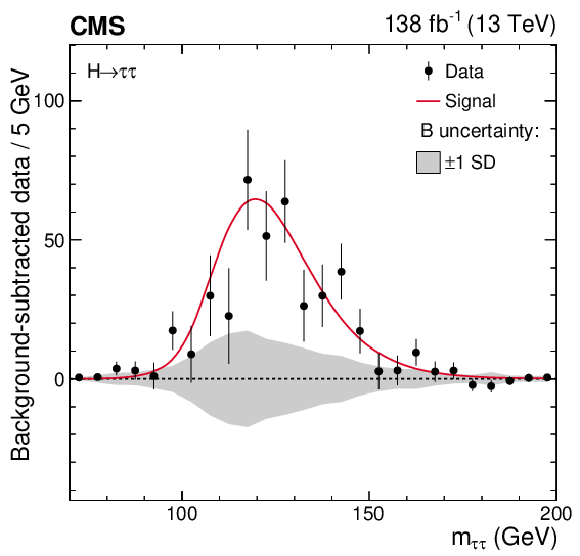
png pdf |
Figure B4-a:
The background-subtracted diparticle invariant mass distribution targeting the study of the decay channel H $ \to {\tau \tau} $. The SM prediction for the signal (red line) is scaled by the value of $\mu $, as estimated in the dedicated analysis for that channel, and computed for $m_\mathrm{H} = $ 125.38 GeV. The grey band around zero shows the 1 s.d. uncertainty in the background subtraction. |

png pdf |
Figure B4-b:
The background-subtracted diparticle invariant mass distribution targeting the study of the decay channel H $ \to $ bb. The SM prediction for the signal (red line) is scaled by the value of $\mu $, as estimated in the dedicated analysis for that channel, and computed for $m_\mathrm{H} = $ 125.38 GeV. The grey band around zero shows the 1 s.d. uncertainty in the background subtraction. |

png pdf |
Figure B4-c:
The background-subtracted diparticle invariant mass distribution targeting the study of the decay channel H $ \to \mu \mu $. The SM prediction for the signal (red line) is scaled by the value of $\mu $, as estimated in the dedicated analysis for that channel, and computed for $m_\mathrm{H} = $ 125.38 GeV. The grey band around zero shows the 1 s.d. uncertainty in the background subtraction. |

png pdf |
Figure B5:
Correlations between the measurements of different couplings. Correlation matrices for the fits of the signal strength parameters per production mode $\mu _i$ (left) and per decay mode $\mu ^f$ (right). The values of the correlation coefficients, $\rho $, are indicated both in text and in the color scale. |

png pdf |
Figure B5-a:
Correlation matrix for the fit of the signal strength parameters per production mode $\mu _i$. The values of the correlation coefficients, $\rho $, are indicated both in text and in the color scale. |

png pdf |
Figure B5-b:
Correlation matrix for the fit of the signal strength parameters per decay mode $\mu ^f$. The values of the correlation coefficients, $\rho $, are indicated both in text and in the color scale. |
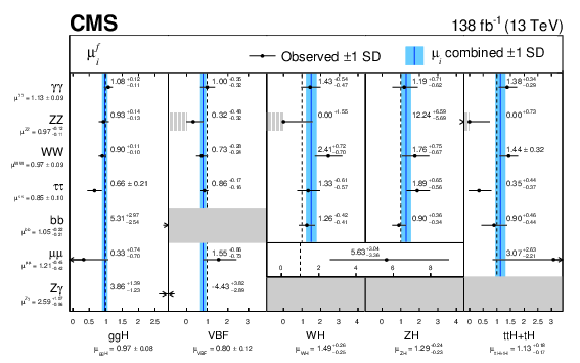
png pdf |
Figure B6:
The agreement with the SM predictions in Higgs boson production and decay. Signal strength parameters per individual production mode and decay channel $\mu _i^f$, and combined per production mode $\mu _i$ and decay channel $\mu ^f$. In this fit, ttH and tH are considered together and the $\mu _i$ results are slightly different from those of Fig. 2 (left). The dashed vertical lines at 1 represent the SM value. Light grey shading indicates that $\mu $ is contained to be positive. Dark grey shading indicates the absence of measurement. The $p$-value with respect to the SM prediction is 5.8%. |

png pdf |
Figure B7:
Time evolution of the signal strength measurements and their precision. Comparison of the signal strength parameter $\mu $ fit results in different data sets; in each panel, from left to right: at the time of the Higgs boson discovery, using the full data from LHC Run 1, in the data set analyzed for this paper, and the expected 1 s.d. uncertainty for HL-LHC for $\mathcal {L}=$ 3000 fb$^{-1}$. The H $ \to \mu \mu $ measurements were not available for the earlier data sets due to the lack of sensitivity. |

png pdf |
Figure B8:
Time evolution of the coupling measurements and their precision. (left) Comparison of the expected 1 s.d. uncertainties in the $\kappa $-framework fit including coupling modifiers for both tree-level and loop-induced Higgs boson interactions, in different data sets: at the time of the Higgs boson discovery, using the full data from LHC Run 1, in the data set used in this paper, and the expected 1 s.d. uncertainty for HL-LHC for $\mathcal {L}=$ 3000 fb$^{-1}$. (right) Results of a fit to the coupling modifiers $\kappa $ allowing both invisible and the undetected decay modes, with the SM value used as an upper bound on both $\kappa _\mathrm{W} $ and $\kappa _\mathrm{Z} $. The thick (thin) black lines indicate the 1 (2) s.d. confidence intervals, with the systematic and statistical components of the 1 s.d. interval indicated by the red and blue bands, respectively. The $p$-value with respect to the SM prediction is 33%. |
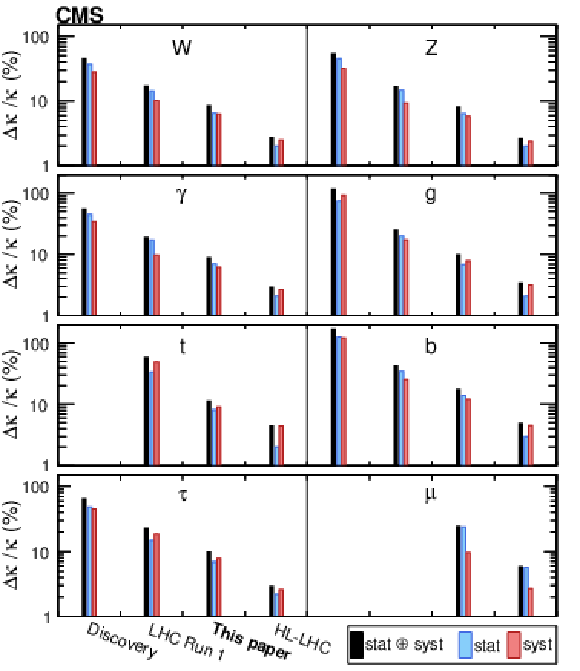
png pdf |
Figure B8-a:
Comparison of the expected 1 s.d. uncertainties in the $\kappa $-framework fit including coupling modifiers for both tree-level and loop-induced Higgs boson interactions, in different data sets: at the time of the Higgs boson discovery, using the full data from LHC Run 1, in the data set used in this paper, and the expected 1 s.d. uncertainty for HL-LHC for $\mathcal {L}=$ 3000 fb$^{-1}$. |

png pdf |
Figure B8-b:
Results of a fit to the coupling modifiers $\kappa $ allowing both invisible and the undetected decay modes, with the SM value used as an upper bound on both $\kappa _\mathrm{W} $ and $\kappa _\mathrm{Z} $. The thick (thin) black lines indicate the 1 (2) s.d. confidence intervals, with the systematic and statistical components of the 1 s.d. interval indicated by the red and blue bands, respectively. The $p$-value with respect to the SM prediction is 33%. |

png pdf |
Figure B9:
Constraints on Higgs boson self-interaction and quartic coupling. (left) Constraints on $ {\kappa _\lambda}$ and $ {\kappa _\mathrm {2V}}$ from the production of Higgs boson pairs. (right) Constraint on the Higgs boson self-coupling modifier $ {\kappa _\lambda}$ from single and pair production of Higgs boson(s). |

png pdf |
Figure B9-a:
Constraints on Higgs boson self-interaction and quartic coupling. (left) Constraints on $ {\kappa _\lambda}$ and $ {\kappa _\mathrm {2V}}$ from the production of Higgs boson pairs. (right) Constraint on the Higgs boson self-coupling modifier $ {\kappa _\lambda}$ from single and pair production of Higgs boson(s). |
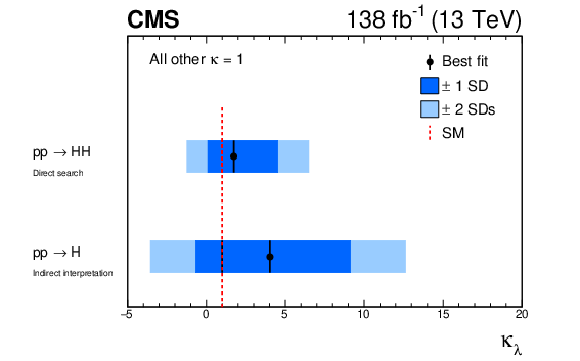
png pdf |
Figure B9-b:
Constraints on Higgs boson self-interaction and quartic coupling. (left) Constraints on $ {\kappa _\lambda}$ and $ {\kappa _\mathrm {2V}}$ from the production of Higgs boson pairs. (right) Constraint on the Higgs boson self-coupling modifier $ {\kappa _\lambda}$ from single and pair production of Higgs boson(s). |
| Tables | |

png pdf |
Table B1:
The SM Higgs production cross sections and branching fractions. Theoretical cross sections for each production mode and branching fractions for the decay channels, at $\sqrt {s}=$ 13 TeV and for $m_{\mathrm{H}} = $ 125.38 GeV [39]. |

png pdf |
Table B2:
Summary of the Higgs boson analyses included in this paper. The analysis and decay channels are indicated in the first two columns, with the third column containing the production mechanism and kinematic regions targeted by each analysis. All analyses, apart from ttH in the H $ \to $ bb final state (2016 data only) and VH in the H $ \to $ bb final state (2016-2017 data), use the full data set collected in Run 2. The various symbols are as follows: $\ell $ is e or $\mu $, jet (j), di-jet mass ($m_\text {jj}$), number of jets ($N_\text {j}$), same-sign (SS) of electric charge, hadronic decay of the tau lepton ($ {\tau _\mathrm {h}} $). |

png pdf |
Table B3:
Summary of the event selections. Some of the typical selection criteria used in the trigger (online selection) and in offline analysis for some of the final states and for leading (1) and subleading (2) particles. The ${{p_{\mathrm {T}}} ^\text {miss}}$ is a measure of the imbalance in energy in the plane transverse to the colliding proton beams. |
| Summary |
|
The discovery of the Higgs boson in 2012 completed the particle content of the standard model (SM) of elementary particle physics, a theory that explains visible matter and its interactions in exquisite detail. The completion of the SM spanned 60 years of theoretical and experimental work. In the ten years following the discovery, great progress has been made in painting a clearer portrait of the Higgs boson. In this paper, the CMS Collaboration reports the most up-to-date combination of results on the properties of the Higgs boson, based on data corresponding to an $\mathcal{L}$ of up to 138 fb$^{-1}$, recorded at 13 TeV. Many of its properties have been determined with accuracies better than 10%. All measurements made so far are found to be consistent with the expectations of the SM. In particular, the overall signal strength parameter has been measured to be $\mu=$ 1.002 $\pm$ 0.057. It has been shown that the Higgs boson directly couples to bottom quarks, tau leptons, and muons, which had not been observed at the time of the discovery, and also proven that it is indeed a scalar particle. The CMS experiment is approaching the sensitivity necessary to probe Higgs boson couplings to charm quarks [74]. The observed (expected) 95% CL value for $\kappa_\mathrm{c}$ is found to be 1.1 $ < |{\kappa_\mathrm{c}}| < $ 5.5 ($|{\kappa_\mathrm{c}}| < $ 3.40), the most stringent result to date. Moreover, the recent progress in searches for the pair production of Higgs bosons has allowed the setting of tight constraints on the Higgs boson self-interaction strength, and the setting of limits on the Higgs boson pair production cross section not much above twice the expected SM value. Much evidence points to the fact that the SM is a low-energy approximation of a more comprehensive theory. In connection with the mechanism of spontaneous symmetry breaking, several puzzles appear: the so-called naturalness, a technical issue related to the fact that the Higgs boson mass is close to the electroweak scale; in relation with cosmology, the metastability of the vacuum state of the SM and the conjectured period of inflation in the early universe; the dynamics of electroweak phase transition and its connection to the matter-antimatter asymmetry of our universe. These issues motivate attempts at obtaining a deeper understanding of the physics of the Higgs boson. The impressive progress made over the last decade is foreseen to continue into the next one. The current data set is expected to be doubled in size by the middle of this decade, enabling the establishment of rare decays channels such as H $ \to \mu\mu$ and H $ \to \mathrm{Z} \gamma$. Operation with the high-luminosity LHC is expected during the next decade and should yield ten times more data then originally foreseen. This should allow the ATLAS and CMS experiments to establish the SM Higgs boson pair production with a significance of 4 s.d., as well as the Higgs boson coupling to charm quarks, and to search for any exotic decays. Improvements in experimental techniques and theoretical calculations are also anticipated to continue. The CMS experiment is entering the era of precision Higgs physics that will shed light on the physics beyond the SM. |
| References | ||||
| 1 | ATLAS Collaboration | Observation of a new particle in the search for the Standard Model Higgs boson with the ATLAS detector at the LHC | PLB 716 (2012) 1 | 1207.7214 |
| 2 | CMS Collaboration | Observation of a new boson at a mass of 125 GeV with the CMS experiment at the LHC | PLB 716 (2012) 30 | CMS-HIG-12-028 1207.7235 |
| 3 | CMS Collaboration | Observation of a new boson with mass near 125 GeV in pp collisions at $ \sqrt{s} = $ 7 and 8 TeV | JHEP 06 (2013) 081 | CMS-HIG-12-036 1303.4571 |
| 4 | F. Englert and R. Brout | Broken symmetry and the mass of gauge vector mesons | PRL 13 (1964) 321 | |
| 5 | P. W. Higgs | Broken symmetries, massless particles and gauge fields | PL12 (1964) 132 | |
| 6 | P. W. Higgs | Broken symmetries and the masses of gauge bosons | PRL 13 (1964) 508 | |
| 7 | G. S. Guralnik, C. R. Hagen, and T. W. B. Kibble | Global conservation laws and massless particles | PRL 13 (1964) 585 | |
| 8 | P. W. Higgs | Spontaneous symmetry breakdown without massless bosons | PR145 (1966) 1156 | |
| 9 | T. W. B. Kibble | Symmetry breaking in non-Abelian gauge theories | PR155 (1967) 1554 | |
| 10 | S. Weinberg | A model of leptons | PRL 19 (1967) 1264 | |
| 11 | A. Salam | Weak and electromagnetic interactions | Conf. Proc. C 680519 (1968) 367 | |
| 12 | S. L. Glashow | Partial symmetries of weak interactions | NP 22 (1961) 579 | |
| 13 | Y. Nambu and G. Jona-Lasinio | Dynamical model of elementary particles based on an analogy with superconductivity. 1. | PR122 (1961) 345 | |
| 14 | G. 't Hooft | Renormalization of massless Yang-Mills fields | NPB 33 (1971) 173 | |
| 15 | G. 't Hooft and M. J. G. Veltman | Regularization and renormalization of gauge fields | NPB 44 (1972) 189 | |
| 16 | UA1 Collaboration | Experimental observation of isolated large transverse energy electrons with associated missing energy at $ \sqrt{s}= $ 540 GeV | PLB 122 (1983) 103 | |
| 17 | UA2 Collaboration | Observation of single isolated electrons of high transverse momentum in events with missing transverse energy at the CERN $ \mathrm{\bar{p}}{\mathrm{p}} $ collider | PLB 122 (1983) 476 | |
| 18 | UA1 Collaboration | Experimental observation of lepton pairs of invariant mass around 95 GeV/$ c^2 $ at the CERN SPS collider | PLB 126 (1983) 398 | |
| 19 | UA2 Collaboration | Evidence for Z$^{0} \to $ e$^{+}$e$^{-}$ at the CERN $ \mathrm{\bar{p}}{\mathrm{p}} $ Collider | PLB 129 (1983) 130 | |
| 20 | L. Evans and P. Bryant | LHC Machine | JINST 3 (2008) S08001 | |
| 21 | LEP Working Group for Higgs boson searches, ALEPH, DELPHI, L3, OPAL Collaboration | Search for the standard model Higgs boson at LEP | PLB 565 (2003) 61 | hep-ex/0306033 |
| 22 | CDF, D0 Collaboration | Evidence for a particle produced in association with weak bosons and decaying to a bottom-antibottom quark pair in Higgs boson searches at the Tevatron | PRL 109 (2012) 071804 | 1207.6436 |
| 23 | G. P. Salam, L. T. Wang, and G. Zanderighi | Higgs turns 10 | In this volume [reference to be supplied by the publisher] | |
| 24 | CMS Collaboration | Precision luminosity measurement in proton-proton collisions at $ \sqrt{s} = $ 13 TeV in 2015 and 2016 at CMS | EPJC 81 (2021) 800 | CMS-LUM-17-003 2104.01927 |
| 25 | CMS Collaboration | The CMS experiment at the CERN LHC | JINST 3 (2008) S08004 | CMS-00-001 |
| 26 | CMS Collaboration | Performance of the CMS Level-1 trigger in proton-proton collisions at $ \sqrt{s} = $ 13 TeV | JINST 15 (2020) P10017 | CMS-TRG-17-001 2006.10165 |
| 27 | CMS Collaboration | The CMS trigger system | JINST 12 (2017) P01020 | CMS-TRG-12-001 1609.02366 |
| 28 | CMS Collaboration | Electron and photon reconstruction and identification with the CMS experiment at the CERN LHC | JINST 16 (2021) P05014 | CMS-EGM-17-001 2012.06888 |
| 29 | CMS Collaboration | Performance of the CMS muon detector and muon reconstruction with proton-proton collisions at $ \sqrt{s}= $ 13 TeV | JINST 13 (2018) P06015 | CMS-MUO-16-001 1804.04528 |
| 30 | CMS Collaboration | Description and performance of track and primary-vertex reconstruction with the CMS tracker | JINST 9 (2014) P10009 | CMS-TRK-11-001 1405.6569 |
| 31 | CMS Collaboration | Particle-flow reconstruction and global event description with the CMS detector | JINST 12 (2017) P10003 | CMS-PRF-14-001 1706.04965 |
| 32 | CMS Collaboration | Identification of hadronic tau lepton decays using a deep neural network | 1, 2022. Submitted to JINST | CMS-TAU-20-001 2201.08458 |
| 33 | CMS Collaboration | Jet energy scale and resolution in the CMS experiment in pp collisions at 8 TeV | JINST 12 (2017) P02014 | CMS-JME-13-004 1607.03663 |
| 34 | CMS Collaboration | Performance of missing transverse momentum reconstruction in proton-proton collisions at $ \sqrt{s} = $ 13 TeV using the CMS detector | JINST 14 (2019) P07004 | CMS-JME-17-001 1903.06078 |
| 35 | CMS Collaboration | Precise determination of the mass of the Higgs boson and tests of compatibility of its couplings with the standard model predictions using proton collisions at 7 and 8 TeV | EPJC 75 (2015) 212 | CMS-HIG-14-009 1412.8662 |
| 36 | LHC Higgs Cross Section Working Group | Handbook of LHC Higgs cross sections: 1. Inclusive observables | CERN Yellow Rep. Monogr. 2 (2011) | 1101.0593 |
| 37 | LHC Higgs Cross Section Working Group | Handbook of LHC Higgs cross sections: 2. Differential distributions | CERN Yellow Rep. Monogr. 2 (2012) | 1201.3084 |
| 38 | LHC Higgs Cross Section Working Group | Handbook of LHC Higgs cross sections: 3. Higgs properties | CERN Yellow Rep. Monogr. 4 (2013) | 1307.1347 |
| 39 | LHC Higgs Cross Section Working Group | Handbook of LHC Higgs Cross Sections: 4. Deciphering the nature of the Higgs sector | CERN Yellow Rep. Monogr. 2 (2017) | 1610.07922 |
| 40 | ATLAS and CMS Collaborations, and the LHC Higgs Combination Group | Procedure for the LHC Higgs boson search combination in Summer 2011 | ATL-PHYS-PUB-2011-011, CMS NOTE-2011/005 | |
| 41 | CMS Collaboration | A measurement of the Higgs boson mass in the diphoton decay channel | PLB 805 (2020) 135425 | CMS-HIG-19-004 2002.06398 |
| 42 | CMS Collaboration | Measurements of Higgs boson production cross sections and couplings in the diphoton decay channel at $ \sqrt{s} = $ 13 TeV | JHEP 07 (2021) 027 | CMS-HIG-19-015 2103.06956 |
| 43 | CMS Collaboration | Measurements of production cross sections of the Higgs boson in the four-lepton final state in proton-proton collisions at $ \sqrt{s} = $ 13 TeV | EPJC 81 (2021) 488 | CMS-HIG-19-001 2103.04956 |
| 44 | CMS Collaboration | Measurements of the Higgs boson production cross section and couplings in the W boson pair decay channel in proton-proton collisions at $ \sqrt{s} = $ 13 TeV | 6, 2022. Submitted to EPJC | CMS-HIG-20-013 2206.09466 |
| 45 | CMS Collaboration | Search for Higgs boson decays to a Z boson and a photon in proton-proton collisions at $ \sqrt{s} = $ 13 TeV | 4, 2022. Submitted to JHEP | CMS-HIG-19-014 2204.12945 |
| 46 | CMS Collaboration | Measurements of Higgs boson production in the decay channel with a pair of $ \tau $ leptons in proton-proton collisions at $ \sqrt{s} = $ 13 TeV | 4, 2022. Submitted to EPJC | CMS-HIG-19-010 2204.12957 |
| 47 | CMS Collaboration | Evidence for the Higgs boson decay to a bottom quark-antiquark pair | PLB 780 (2018) 501 | CMS-HIG-16-044 1709.07497 |
| 48 | CMS Collaboration | Observation of Higgs boson decay to bottom quarks | PRL 121 (2018) 121801 | CMS-HIG-18-016 1808.08242 |
| 49 | CMS Collaboration | Search for $ \mathrm{t}\mathrm{\bar{t}} $H production in the all-jet final state in proton-proton collisions at $ \sqrt{s} = $ 13 TeV | JHEP 06 (2018) 101 | CMS-HIG-17-022 1803.06986 |
| 50 | CMS Collaboration | Search for $ \mathrm{t}\mathrm{\bar{t}}$H production in the H $\to \mathrm{b}\mathrm{\bar{b}} $ decay channel with leptonic $ \mathrm{t}\mathrm{\bar{t}} $ decays in proton-proton collisions at $ \sqrt{s} = $ 13 TeV | JHEP 03 (2019) 026 | CMS-HIG-17-026 1804.03682 |
| 51 | CMS Collaboration | Inclusive search for highly boosted Higgs bosons decaying to bottom quark-antiquark pairs in proton-proton collisions at $ \sqrt{s} = $ 13 TeV | JHEP 12 (2020) 085 | CMS-HIG-19-003 2006.13251 |
| 52 | CMS Collaboration | Evidence for Higgs boson decay to a pair of muons | JHEP 01 (2021) 148 | CMS-HIG-19-006 2009.04363 |
| 53 | CMS Collaboration | Measurement of the Higgs boson production rate in association with top quarks in final states with electrons, muons, and hadronically decaying tau leptons at $ \sqrt{s} = $ 13 TeV | EPJC 81 (2021) 378 | CMS-HIG-19-008 2011.03652 |
| 54 | M. Grazzini et al. | Higgs boson pair production at NNLO with top quark mass effects | JHEP 05 (2018) 059 | 1803.02463 |
| 55 | J. Baglio et al. | gg $\to $ HH : Combined uncertainties | PRD 103 (2021) 056002 | 2008.11626 |
| 56 | F. A. Dreyer and A. Karlberg | Vector-boson fusion Higgs pair production at N$ ^3 $LO | PRD 98 (2018) 114016 | 1811.07906 |
| 57 | CMS Collaboration | Search for Higgs boson pair production in the four b quark final state in proton-proton collisions at $ \sqrt{s} = $ 13 TeV | 2, 2022. Submitted to PRL | CMS-HIG-20-005 2202.09617 |
| 58 | CMS Collaboration | Search for nonresonant pair production of highly energetic Higgs bosons decaying to bottom quarks | 5, 2022. Accepted by PRL | CMS-B2G-22-003 2205.06667 |
| 59 | CMS Collaboration | Search for nonresonant Higgs boson pair production in final state with two bottom quarks and two tau leptons in proton-proton collisions at $ \sqrt{s} = $ 13 TeV | 6, 2022. Submitted to PLB | CMS-HIG-20-010 2206.09401 |
| 60 | CMS Collaboration | Search for Higgs boson pairs decaying to WWWW, WW$ \tau\tau $, and $ \tau\tau\tau\tau $ in proton-proton collisions at $ \sqrt{s} = $ 13 TeV | 6, 2022. Submitted to JHEP | CMS-HIG-21-002 2206.10268 |
| 61 | CMS Collaboration | Search for nonresonant Higgs boson pair production in final states with two bottom quarks and two photons in proton-proton collisions at $ \sqrt{s} = $ 13 TeV | JHEP 03 (2021) 257 | CMS-HIG-19-018 2011.12373 |
| 62 | CMS Collaboration | Search for nonresonant Higgs boson pair production in the four leptons plus two b jets final state in proton-proton collisions at $ \sqrt{s} = $ 13 TeV | 6, 2022. Submitted to JHEP | CMS-HIG-20-004 2206.10657 |
| 63 | CMS Collaboration | Evidence for the direct decay of the 125 GeV Higgs boson to fermions | NP 10 (2014) 557 | CMS-HIG-13-033 1401.6527 |
| 64 | CMS Collaboration | Constraints on the spin-parity and anomalous HVV couplings of the Higgs boson in proton collisions at 7 and 8 TeV | PRD 92 (2015) 012004 | CMS-HIG-14-018 1411.3441 |
| 65 | ATLAS Collaboration | Study of the spin and parity of the Higgs boson in diboson decays with the ATLAS detector | EPJC 75 (2015) 476 | 1506.05669 |
| 66 | CMS Collaboration | Observation of the Higgs boson decay to a pair of $ \tau $ leptons with the CMS detector | PLB 779 (2018) 283 | CMS-HIG-16-043 1708.00373 |
| 67 | CMS Collaboration | Observation of $ \mathrm{t}\mathrm{\bar{t}}$H production | PRL 120 (2018) 231801 | CMS-HIG-17-035 1804.02610 |
| 68 | CMS Collaboration | First evidence for off-shell production of the Higgs boson and measurement of its width | 2022. Submitted to Nature Phys | CMS-HIG-21-013 2202.06923 |
| 69 | M. Cepeda et al. | Report from Working Group 2: Higgs physics at the HL-LHC and HE-LHC | CERN Yellow Rep. Monogr. 7 (2019) 221 | 1902.00134 |
| 70 | CMS Collaboration | Search for invisible decays of the Higgs boson produced via vector boson fusion in proton-proton collisions at $ \sqrt{s} = $ 13 TeV | 2022. Submitted to PRD | CMS-HIG-20-003 2201.11585 |
| 71 | CMS Collaboration | Search for new particles in events with energetic jets and large missing transverse momentum in proton-proton collisions at $ \sqrt{s} = $ 13 TeV | JHEP 11 (2021) 153 | CMS-EXO-20-004 2107.13021 |
| 72 | CMS Collaboration | Search for dark matter produced in association with a leptonically decaying Z boson in proton-proton collisions at $ \sqrt{s} = $ 13 TeV | EPJC 81 (2021) 13 | CMS-EXO-19-003 2008.04735 |
| 73 | CMS Collaboration | Combination of searches for Higgs boson pair production in proton-proton collisions at $ \sqrt{s} = $ 13 TeV | PRL 122 (2019) 121803 | CMS-HIG-17-030 1811.09689 |
| 74 | CMS Collaboration | Search for Higgs boson decay to a charm quark-antiquark pair in proton-proton collisions at $ \sqrt{s} = $ 13 TeV | 5, 2022. Submitted to PRL | CMS-HIG-21-008 2205.05550 |
| 75 | CMS Collaboration | Performance of the DeepJet b tagging algorithm using 41.9 fb$^{-1}$ of data from proton-proton collisions at 13 TeV with Phase 1 CMS detector | CDS | |
| 76 | E. Bols et al. | Jet flavour classification using DeepJet | JINST 15 (2020) P12012 | 2008.10519 |
| 77 | J. F. Gunion, H. E. Haber, and J. Wudka | Sum rules for Higgs bosons | PRD 43 (1991) 904 | |
| 78 | C. Englert et al. | Precision measurements of Higgs couplings: implications for new physics scales | JPG 41 (2014) 113001 | 1403.7191 |
| 79 | G. Cowan, K. Cranmer, E. Gross, and O. Vitells | Asymptotic formulae for likelihood-based tests of new physics | EPJC 71 (2011) 1554 | 1007.1727 |
| 80 | G. Isidori, G. Ridolfi, and A. Strumia | On the metastability of the standard model vacuum | NPB 609 (2001) 387 | hep-ph/0104016 |
| 81 | G. Degrassi, P. P. Giardino, F. Maltoni, and D. Pagani | Probing the Higgs self coupling via single Higgs production at the LHC | JHEP 12 (2016) 080 | 1607.04251 |
| 82 | F. Maltoni, D. Pagani, A. Shivaji, and X. Zhao | Trilinear Higgs coupling determination via single-Higgs differential measurements at the LHC | EPJC 77 (2017) 887 | 1709.08649 |
| 83 | F. Monti et al. | Modelling of the single-Higgs simplified template cross-sections (STXS 1.2) for the determination of the Higgs boson trilinear self-coupling | LHCHWG-2022-002 | |
| 84 | A. V. Gritsan, R. Roentsch, M. Schulze, and M. Xiao | Constraining anomalous Higgs boson couplings to the heavy flavor fermions using matrix element techniques | PRD 94 (2016) 055023 | 1606.03107 |
| 85 | A. V. Gritsan et al. | New features in the JHU generator framework: constraining Higgs boson properties from on-shell and off-shell production | PRD 102 (2020) 056022 | 2002.09888 |
| 86 | F. Demartin et al. | tWH associated production at the LHC | EPJC 77 (2017) 34 | 1607.05862 |
| 87 | R. Frederix and K. Hamilton | Extending the MINLO method | JHEP 05 (2016) 042 | 1512.02663 |
| 88 | NNPDF Collaboration | Parton distributions from high-precision collider data | EPJC 77 (2017) 663 | 1706.00428 |
| 89 | J. S. Gainer et al. | Exploring theory space with Monte Carlo reweighting | JHEP 10 (2014) 078 | 1404.7129 |
| 90 | O. Mattelaer | On the maximal use of Monte Carlo samples: re-weighting events at NLO accuracy | EPJC 76 (2016) 674 | 1607.00763 |
| 91 | S. Alioli et al. | Jet pair production in POWHEG | JHEP 04 (2011) 081 | 1012.3380 |
| 92 | K. Melnikov and F. Petriello | Electroweak gauge boson production at hadron colliders through $ \mathcal{O}(\alpha_\text{s}^{2}) $ | PRD 74 (2006) 114017 | hep-ph/0609070 |
| 93 | M. Czakon and A. Mitov | Top++: A program for the calculation of the top-pair cross-section at hadron colliders | CPC 185 (2014) 2930 | 1112.5675 |
| 94 | N. Kidonakis | Top quark production | in Helmholtz International Summer School on Physics of Heavy Quarks and Hadrons, 2014 | 1311.0283 |
| 95 | Y. Li and F. Petriello | Combining QCD and electroweak corrections to dilepton production in FEWZ | PRD 86 (2012) 094034 | 1208.5967 |
| 96 | M. Grazzini, S. Kallweit, D. Rathlev, and M. Wiesemann | W$ ^\pm$Z production at the LHC: fiducial cross sections and distributions in NNLO QCD | JHEP 05 (2017) 139 | 1703.09065 |
| 97 | J. M. Lindert et al. | Precise predictions for V+jets dark matter backgrounds | EPJC 77 (2017) 829 | 1705.04664 |
| 98 | S. Kallweit et al. | NLO QCD+EW automation and precise predictions for V+multijet production | in 50th Rencontres de Moriond, QCD and high energy interactions, 2015 | 1505.05704 |
| 99 | S. Kallweit et al. | NLO QCD+EW predictions for V+jets including off-shell vector-boson decays and multijet merging | JHEP 04 (2016) 021 | 1511.08692 |
| 100 | K. Becker et al. | Precise predictions for boosted Higgs production | 2020 | 2005.07762 |
| 101 | F. A. Dreyer and A. Karlberg | Vector-boson fusion Higgs production at three loops in QCD | PRL 117 (2016) 072001 | 1606.00840 |
| 102 | R. Bonciani et al. | Next-to-leading order QCD corrections to the decay width H $\to$ Z$\gamma $ | JHEP 08 (2015) 108 | 1505.00567 |
| 103 | T. Gehrmann, S. Guns, and D. Kara | The rare decay H $\to$ Z$\gamma $ in perturbative QCD | JHEP 09 (2015) 038 | 1505.00561 |
| 104 | G. Heinrich et al. | NLO predictions for Higgs boson pair production with full top quark mass dependence matched to parton showers | JHEP 08 (2017) 088 | 1703.09252 |
| 105 | G. Heinrich et al. | Probing the trilinear Higgs boson coupling in di-Higgs production at NLO QCD including parton shower effects | JHEP 06 (2019) 066 | 1903.08137 |
| 106 | S. P. Jones and S. Kuttimalai | Parton shower and NLO-matching uncertainties in Higgs boson pair production | JHEP 02 (2018) 176 | 1711.03319 |
| 107 | G. Heinrich, S. P. Jones, M. Kerner, and L. Scyboz | A non-linear EFT description of gg $\to $ HH at NLO interfaced to POWHEG | JHEP 10 (2020) 021 | 2006.16877 |
| 108 | G. Buchalla et al. | Higgs boson pair production in non-linear Effective Field Theory with full $ m_\mathrm{t} $-dependence at NLO QCD | JHEP 09 (2018) 057 | 1806.05162 |

|
Compact Muon Solenoid LHC, CERN |

|

|

|

|

|

|